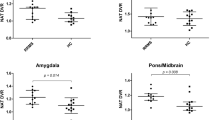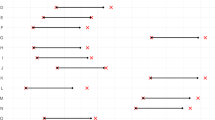Abstract
Purpose
Modulation of the immune system by the CNS may involve serotonergic regulation via the brain serotonin transporters (SERT). This regulation may be disturbed in patients with CNS disorders including multiple sclerosis (MS). Central serotonergic mechanisms have not been investigated in MS by in vivo imaging. The objective of the study was to assess the availability of SERT in antidepressant-naive patients with MS by means of PET.
Methods
Included in this study were 23 patients with MS and 22 matched healthy volunteers who were investigated with PET and the SERT-selective marker [11C]DASB, and distribution volume ratios were determined. Clinical assessment of the patients included the expanded disability status scale, the MS fatigue scale Würzburger Erschöpfungsinventar bei MS (WEIMuS) and the Beck Depression Inventory (BDI). The PET data were analysed with both volume-of-interest and voxel-based analyses to determine regional SERT availability.
Results
Patients had lower SERT availability in the cingulate cortex, the thalamus and the insula, and increased availability in the orbitofrontal cortex. Patients with relapsing/remitting MS tended to have lower SERT in the hippocampus, whereas patients with primary progressive disease showed increased SERT availability in prefrontal regions. There was a positive correlation between SERT availability in the insula and both depression and fatigue scores (r = 0.56 vs. BDI, p = 0.02; r = 0.49 vs. WEIMuS, p = 0.05).
Conclusion
Serotonergic neurotransmission in MS patients is altered in limbic and paralimbic regions as well as in the frontal cortex that this appears to contribute to psychiatric symptoms of MS.




Similar content being viewed by others
References
Hemmer B, Nessler S, Zhou D, Kieseier B, Hartung HP. Immunopathogenesis and immunotherapy of multiple sclerosis. Nat Clin Pract Neurol. 2006;2:201–11.
Hofstetter HH, Mössner R, Lesch KP, Linker RA, Toyka KV, Gold R. Absence of reuptake of serotonin influences susceptibility to clinical autoimmune disease and neuroantigen-specific interferon-gamma production in mouse EAE. Clin Exp Immunol. 2005;142:39–44.
Taler M, Gil-Ad I, Korob I, Weizman A. The immunomodulatory effect of the antidepressant sertraline in an experimental autoimmune encephalomyelitis mouse model of multiple sclerosis. Neuroimmunomodulation. 2011;18:117–22.
Yuan XQ, Qiu G, Liu XJ, Liu S, Wu Y, Wang X, et al. Fluoxetine promotes remission in acute experimental autoimmune encephalomyelitis in rats. Neuroimmunomodulation. 2012;19:201–8.
Mostert JP, Admiraal-Behloul F, Hoogduin JM, Luyendijk J, Heersema DJ, van Buchem MA, et al. Effects of fluoxetine on disease activity in relapsing multiple sclerosis: a double-blind, placebo-controlled, exploratory study. J Neurol Neurosurg Psychiatry. 2008;79:1027–31.
Krupp LB, Serafin DJ, Christodoulou C. Multiple sclerosis-associated fatigue. Expert Rev Neurother. 2010;10:1437–47.
Solaro C, Bergamaschi R, Rezzani C, Mueller M, Trabucco E, Bargiggia V, et al. Duloxetine is effective in treating depression in multiple sclerosis patients: an open-label multicenter study. Clin Neuropharmacol. 2013;36:114–6. doi:10.1097/WNF.0b013e3182996400.
Mitsonis CI, Zervas IM, Potagas CM, Mitropoulos PA, Dimopoulos NP, Sfagos CA, et al. Effects of escitalopram on stress-related relapses in women with multiple sclerosis: an open-label, randomized, controlled, one-year follow-up study. Eur Neuropsychopharmacol. 2010;20:123–31.
Poser CM, Paty DW, Scheinberg L, McDonald WI, Davis FA, Ebers GC, et al. New diagnostic criteria for multiple sclerosis: guidelines for research protocols. Ann Neurol. 1983;13:227–31.
Polman CH, Reingold SC, Edan G, Filippi M, Hartung HP, Kappos L, et al. Diagnostic criteria for multiple sclerosis: 2005 revisions to the "McDonald Criteria". Ann Neurol. 2005;58:840–6.
Kurtzke JF. Rating neurologic impairment in multiple sclerosis: an expanded disability status scale. Neurology. 1983;33:1444–52.
Flachenecker P, Müller G, König H, Meissner H, Toyka KV, Rieckmann P. Fatigue in multiple sclerosis. Development and validation of the Würzburger Fatigue Inventory for MS. Nervenarzt. 2006;77:165–6. 168–170, 172–4.
Hautzinger M. The Beck Depression Inventory in clinical practice. Nervenarzt. 1991;62:689–96.
Hesse S, Stengler K, Regenthal R, Patt M, Becker GA, Franke A, et al. The serotonin transporter availability in untreated early-onset and late-onset patients with obsessive–compulsive disorder. Int J Neuropsychopharm. 2011;14:606–17.
Ichise M, Liow JS, Lu JQ, Takano A, Model K, Toyama H, et al. Linearized reference tissue parametric imaging methods: application to [11C]DASB positron emission tomography studies of the serotonin transporter in human brain. J Cereb Blood Flow Metab. 2003;23:1096–112.
R Development Core Team (2011) R: a language and environment for statistical computing. R Foundation for Statistical Computing, Vienna, Austria. ISBN 3-900051-07-0, URL http://www.R-project.org/.
Cleare AJ, Messa C, Rabiner EA, Grasby PM. Brain 5-HT1A receptor binding in chronic fatigue syndrome measured using positron emission tomography and [11C]WAY-100635. Biol Psychiatry. 2005;57:239–46.
Yamamoto S, Ouchi Y, Onoe H, Yoshikawa E, Tsukada H, Takahashi H, et al. Reduction of serotonin transporters of patients with chronic fatigue syndrome. Neuroreport. 2004;15:2571–4.
Groenewold NA, Opmeer EM, de Jonge P, Aleman A, Costafreda SG. Emotional valence modulates brain functional abnormalities in depression: evidence from a meta-analysis of fMRI studies. Neurosci Biobehav Rev. 2013;37:152–63.
Hulst HE, Schoonheim MM, Roosendaal SD, Popescu V, Schweren LJ, van der Werf YD, et al. Functional adaptive changes within the hippocampal memory system of patients with multiple sclerosis. Hum Brain Mapp. 2012;33:2268–80.
Parisi L, Rocca MA, Valsasina P, Panicari L, Mattioli F, Filippi M. Cognitive rehabilitation correlates with the functional connectivity of the anterior cingulate cortex in patients with multiple sclerosis. Brain Imaging Behav. 2012. doi:10.1007/s11682-012-9160-9.
Crespy L, Zaaraoui W, Lemaire M, Rico A, Faivre A, Reuter F, et al. Prevalence of grey matter pathology in early multiple sclerosis assessed by magnetization transfer ratio imaging. PLOS One. 2011;6:e24969.
Dineen RA, Bradshaw CM, Constantinescu CS, Auer DP. Extra-hippocampal subcortical limbic involvement predicts episodic recall performance in multiple sclerosis. PLOS One. 2012;7:e4494.
Stys PK, Zamponi GW, van Minnen J, Geurts JJ. Will the real multiple sclerosis please stand up? Nat Rev Neurosci. 2012;13:507–14.
Tomassini V, Johansen-Berg H, Jbabdi S, Wise RG, Pozzilli C, Palace J, et al. Relating brain damage to brain plasticity in patients with multiple sclerosis. Neurorehabil Neural Repair. 2012;26:581–93.
Forn C, Rocca MA, Boscá I, Casanova B, Sanjuan A, Filippi M. Analysis of “task-positive” and “task-negative” functional networks during the performance of the Symbol Digit Modalities Test in patients at presentation with clinically isolated syndrome suggestive of multiple sclerosis. Exp Brain Res. 2013;225:399–407. doi:10.1007/s00221-012-3380-5.
Liu Y, Duan Y, Liang P, Jia X, Yu C, Ye J, et al. Baseline brain activity changes in patients with clinically isolated syndrome revealed by resting-state functional MRI. Acta Radiol. 2012;53:1073–8.
Hawellek DJ, Hipp JF, Lewis CM, Corbetta M, Engel AK. Increased functional connectivity indicates the severity of cognitive impairment in multiple sclerosis. Proc Natl Acad Sci U S A. 2011;108:19066–71.
Pavese N, Metta V, Bose SK, Chaudhuri KR, Brooks DJ. Fatigue in Parkinson’s disease is linked to striatal and limbic serotonergic dysfunction. Brain. 2010;133:3434–43.
Kranz GS, Hahn A, Baldinger P, Haeusler D, Philippe C, Kaufmann U, et al. Cerebral serotonin transporter asymmetry in females, males and male-to-female transsexuals measured by PET in vivo. Brain Struct Funct. 2012. doi:10.1007/s00429-012-0492-4.
Martinez A, Finegersh A, Cannon DM, Dustin I, Nugent A, Herscovitch P, et al. The 5-HT1A receptor and 5-HT transporter in temporal lobe epilepsy. Neurology. 2013;80:1465–71.
Acknowledgment
We are grateful to Bärbel Schellenberg for helping us with genotype analysis.
Conflicts of interest
None.
Author information
Authors and Affiliations
Corresponding author
Additional information
Florian Then Bergh and Osama Sabri contributed equally to this work.
Rights and permissions
About this article
Cite this article
Hesse, S., Moeller, F., Petroff, D. et al. Altered serotonin transporter availability in patients with multiple sclerosis. Eur J Nucl Med Mol Imaging 41, 827–835 (2014). https://doi.org/10.1007/s00259-013-2636-z
Received:
Accepted:
Published:
Issue Date:
DOI: https://doi.org/10.1007/s00259-013-2636-z




